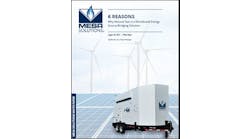Michelle Moore, former sustainability chief under President Obama, is keen on building microgrids to provide resilience and clean power for rural areas.
Rural communities experience outages that are longer and more frequent than those in urban areas, said Moore, author of a new book, “Rural Renaissance: Revitalizing America’s Hometowns Through Clean Power.”
Rural towns also have less ability to apply for grants and incentives and often need the help of third parties such as microgrid developers. Her book outlines some of the ways that communities can partner with third parties to finance and deploy microgrids and boost resilience.
“Microgrids are fundamentally part of the clean energy future we talk about in the book,” said Moore, who is CEO of Groundswell, a nonprofit organization that focuses on bringing solar and microgrids to low-income communities.
New federal aid for rural communities
The Inflation Reduction Act (IRA), signed in August by US President Joe Biden, provides an unprecedented level of funding for rural communities, including for resilience and microgrids, Moore said, adding that the law was enacted after she completed the book.
The IRA includes $10 billion for rural utilities and $40 billion for manufacturing energy technology in the US.
The law also changes the existing investment tax credit (ITC) so that it is refundable to nonprofit organizations, a big plus for rural communities, Moore said. In order to take advantage of the ITC before, nonprofits had to partner with third parties with a tax appetite. Now, nonprofit organizations can own their own solar and storage assets and benefit from the tax credits. “That’s powerful for engaging rural utilities,” she said.
Moore’s book aims to help local leaders apply for funding and implement resilience projects, and it suggests that rural communities partner with technology providers, nonprofit organizations and large commercial energy users seeking resilience.
How rural areas can adopt microgrids
In rural areas, it makes sense for third parties to come to the towns and become service providers, said Moore. For example, a microgrid company could partner with a local utility to offer resilience-as-a-service, a program under which the third party owns the equipment.
Or third parties, working with utilities, could install microgrids for homes and businesses and control a portion of the battery for the purpose of providing grid services. One example, she said, is CPS Energy in San Antonio, Texas, which worked with a third party to install solar and storage in homes in rural areas. CPS Energy controls the battery during peak hours.
Another option for rural communities is partnering with microgrid equipment vendors and research organizations to launch pilot programs that can inform other communities. Smart Neighborhood, a community of 62 homes powered by a microgrid, formed through a partnership that included Alabama Power, developer Signature Homes, Oak Ridge National Laboratory and technology vendors. The goal is to understand the benefits of smart systems, including microgrids.
Resilience hubs
“Using the intelligence of microgrids to create a very salient energy community enables people and businesses to share the benefits,” according to Moore’s book.
In addition to neighborhoods, churches and other nonprofit organizations in rural communities should consider becoming resilience hubs, according to Moore. Working with Groundswell and the city of Baltimore, Maryland, The Empowerment Temple is installing solar and energy storage to serve as a community resilience hub for the residents in Baltimore’s Park Heights neighborhood. The hub can help neighborhood residents during severe weather or outages with housing supplies, information about emergencies or by providing a place to charge their phones.
Communities can also join hands with large commercial energy users that are looking to reduce the risk of outages. For example, locating energy storage at hospitals and municipal water facilities yields opportunities to share resources such as clean water during outages with the community.
Meanwhile, Moore’s company, Groundswell, has embraced Moore’s ideas and deployed some microgrids to provide resilience in low-income communities.
Groundswell has been working with the city of Baltimore to plan and design community resilience hubs in vulnerable communities. The organization has identified locations where community members can gain access to reliable power for devices, learn about emergencies and store medications sensitive to temperature.
Two of these hubs have already been completed in Baltimore, and three more are in different phases of planning.
In Atlanta, Georgia, Groundswell is working in partnership with Spelman College on equity projects. The company has received funding to begin technical development of a microgrid at a Baptist church that will be a resilient energy center. Construction is expected to begin at the end of the year.
Deploying community microgrids as resilience centers yields many benefits, said Moore. For example, a microgrid at the City of Refuge Church in Baltimore kept the lights on when there was a large fire a block away and the fire department had to shut down power.
“The City of Refuge was able to keep its power on and served firemen lunch,” she said. And community members without power were able to gather at the church.
Rural leadership
In her work researching resilience hubs in rural areas, Moore was inspired by the people leading the resilience effort.
“One thing I loved about writing the book: There were so many examples of rural leadership, programs you can replicate and leaders you can follow,” Moore said.
Track news about rural microgrids. Subscribe to the free Microgrid Knowledge Newsletter.








